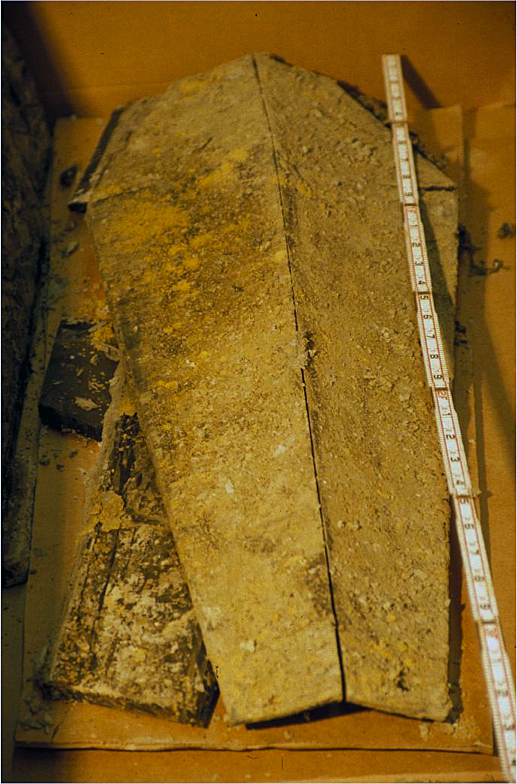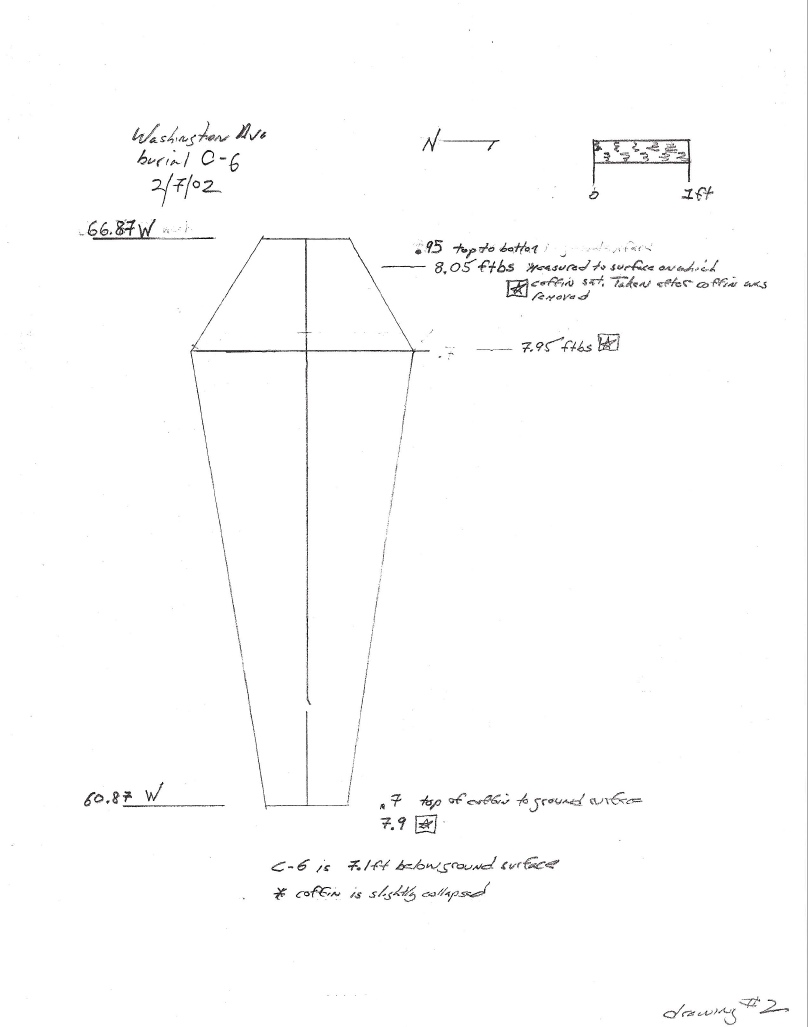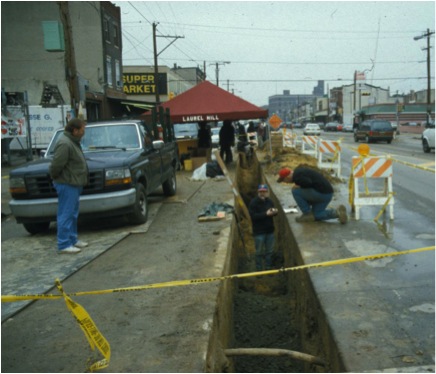June 2014 – Artifact of the Month
Back to PAF Home
Back to Artifact of the Month Index
Back to Burial Places Forum
The Buried Past Along Washington Avenue in South Philadelphia
A Surprise Discovery

This hexagonal, arched- top, coffin was discovered along Washington Avenue during a 2002 water line renovation project.
In 2002, sixteen coffins, and portions of two others, were excavated from the 700 block of Washington Avenue, between Passyunk and 8th Street, in South Philadelphia. The coffins were encountered during the digging of a water department construction trench. Long ago, this area comprised the southern margins of the city. Historical records also indicate that it was the location of several cemeteries. In laying a new waterline in this now bustling, South Philadelphia, neighborhood, some of the city’s earlier history was discovered.
View of water line trench, Washington Avenue, looking toward 8th Street (2002). All of the burials were discovered to the west of the individuals in the foreground. (Figure 1., page 3, in R. Michael Stewart, 2005, “Summary of Archaeological Salvage of Burials, Washington Avenue, Philadelphia”, Temple University, Philadelphia, PA
After the Philadelphia Police were contacted, and after obtaining an exhumation order from the Orphan’s Court (Philadelphia, First Judicial District of Pennsylvania), physical anthropologists and archaeologists from Temple University, working with various volunteers and with staff from the Laurel Hill Cemetery, removed the encountered burials. Standard archaeological techniques were used in the excavation. The en-coffined burials were examined at the Laboratory of Anthropology at Temple University and were then reburied in Laurel Hill Cemetery. (Read some of the news coverage at the time of the surprise discovery here and here.)
Physical anthropological study of the human remains found that the burials represented children and adults of both sexes. Historical research identified the few material items recovered with the coffins. These included silk ribbon associated with some of the child burials, a yellow metal wedding band and a folded woolen shawl or blanket from the burial of an adult female, bone buttons from the clothing of an adult male, and fragments of a white clay pipe stem found within grave shaft fill. An abundance of wood shavings presumably used as pillow fill and as absorption matter was also found.
The recovered coffins held single burials (only one individual). Many of the coffins were found stacked one upon another in their grave shafts (a typically older burial practice, often for a family or group burial). The heads of the coffins were positioned oriented to the west. The coffins, made of wood, were hexagonal in shape. Most were flat topped, with a few having an arched-style top. Ornamental white metal strapping was found associated with some of the coffins.

Washington Ave burial C-6, drawing #2, Appendix B: Scaled Field Drawings of Coffins, in R. Michael Stewart (2005, Temple University, Philadelphia, PA), “Summary of Archaeological Salvage of Burials, Washington Avenue, Philadelphia”
Initially, the coffin burials were thought to be Civil War era and possibly Civil War-related. However, the coffin architectural characteristics and the burial style (stacked), along with the artifacts and historical records suggested that the burials were interred in the first half of the 19th-century, marking them as at least 150 years old (interred +-1800 through 1850, before the Civil War). Documentary research indicated that the coffin burials were likely associated with the Bishop’s Ground, a Catholic cemetery first opened in 1824. (See adjacent 1905 map of Philadelphia.) This cemetery, and others in the vicinity, were moved when the expanding city encroached into the area but – as has been known to happen elsewhere – some of the burials were presumably missed. If the stacked coffins hold family members who died close together in time, these coffins may be evidence of one of the epidemics (cholera, yellow fever) that plagued the early city.
Learn more about these coffin burials and the research resulting from their discovery:
Partnering In a South Philadelphia Dig: The Washington Avenue Bioarchaeology Project Poster presentation at the 2007 American Association of Physical Anthropologists, Philadelphia, PA.
Prepared by: A. Washburn (Department of Anatomy and Cell Biology, Temple University School of Medicine), T.A. Crist (Program in Physical Therapy, Utica College), M.B. Goldberg (Private practice in Philadelphia) and M. Kirkpatrick (Department of Anthropology, Temple University)
Summary of Archaeological Salvage of Burials, Washington Avenue, Philadelphia
By R. Michael Stewart (2005) Temple University, Philadelphia, PA.
Part 1 Washington Ave Burials Report.Stewart 2005. Pages 1 to 10
Part 2 Washington Ave Burials Report.Stewart 2005. Pages 11 to 21
Part 3 Washington Ave Burials Report.Stewart 2005. Pages 22 to 34
Colimore, E. March 25, 2005. Historical remains to be moved to vault: Reburial of 200-year-old bodies needs judge’s OK. The Philadelphia Inquirer.
Dilanian, K. February 24, 2002. What to do about the historic remains that lie beneath? The Philadelphia Inquirer.
______________________
This month’s ‘Artifact of the Month’ image is courtesy of Art Washburn and comes from a 2007 poster by A. Washburn, T.A. Crist, M.B. Goldberg, and M. Kirkpatrick, entitled “Partnering In a South Philadelphia Dig: The Washington Avenue Bioarchaeology Project”, that was presented at the 2007 American Association of Physical Anthropologists meeting. The accompanying above write up (abstracted by Patrice L. Jeppson) is drawn from a 2005 report by R. Michael Stewart, “Summary of Archaeological Salvage of Burials, Washington Avenue, Philadelphia”, and from the aforementioned 2007 poster text prepared by A. Washburn et. al.
by admin

